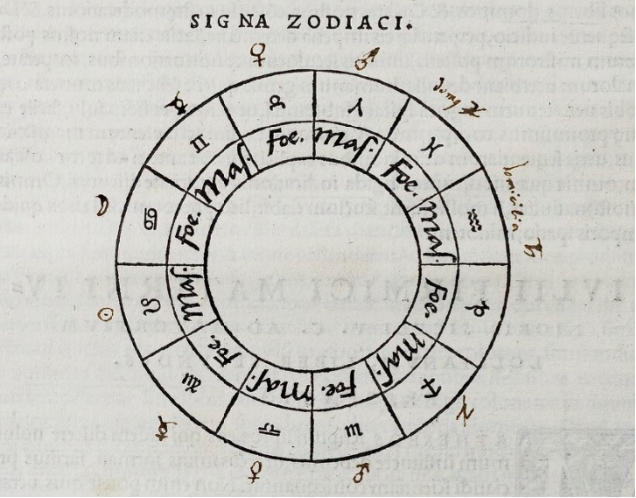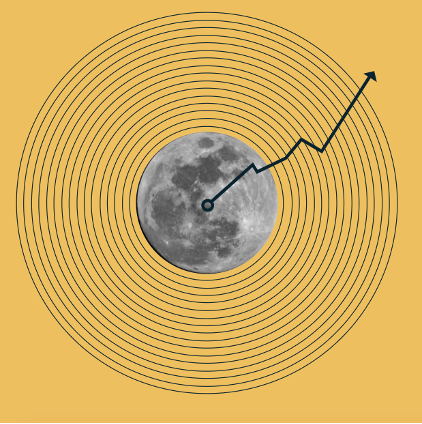Enchantment in the history of science, literature, and art
Speakers
Professor David Morgan, Duke University
Professor Carrie Tirado Bramen, University at Buffalo
Readings
-
David Morgan, “Enchantment and Disenchantment” in Images at Work: The Material Culture of Enchantment (OUP, 2019).
-
Christine Smallwood, “Astrology in the Age of Uncertainty” in The New Yorker, 28 October 2019.
-
Nicholas Campion, “Introduction: Origins and Background” in A History of Western Astrology Volume II: The Medieval and Modern Worlds (Bloomsbury, 2009)
-
Paul Crosthwaite, Peter Knight, and Nicky Marsh, “The Economic Humanities and the History of Financial Advice,” American Literary History, vol. 31, no. 4, pp. 661–686.
Memo

Zodiac sign in Julius Firmicus Maternus, Astronomicon (Basel, 1533), p. 16, with marginalia by John Dee.
Source: The Archaeology of Reading
Bruno Latour writes of catastrophes as opportunities for an enchanted relationship. In that light, the stock market crash of 2008 and the subsequent economic crisis functioned as a moment of enchantment. Seeing something as broken ‘frees it up’: it can be a realisation that prompts redesign and reinterpretation, as well as (re-)enchantment. This observation works both for analyses of global, and in this case economic, structures as well as for analyses of individual material objects. In this roundtable, our speakers David Morgan and Carrie Tirado Bramen explored the dynamics of crisis and redesign from different but intertwined perspectives.
(1) What constitutes enchantment? and (5) Is materiality fundamental to enchantment?
The previous roundtable tested the concept of enchantment in both theoretical and practical ways in histories of religion and magic. This roundtable deepened our historical understanding of the concept, but also broadened it by honing in on its materiality, and on its commodification in one segment of the ‘magical marketplace’: astrology. Morgan used his work on the material culture of enchantment as a starting point to offer a working definition of enchantment as a broader canopy under which religious phenomena coexist with other processes of engagement with the things around us, from tarot cards and animal entrails, to more quotidian, seemingly ordinary objects in secular life.
Drawing on actor-network theory and the agency of matter to assert power, Morgan proposes Enchantment Network Theory in which a human agent engages with an object to exert influence on agencies connected with it. Enchantment is not a psychological projection, but an action. These are the small things we do, distributing agency to make the world go our way. The canopy of enchantment stretches out far and wide – one question afterwards was: ‘What is not enchantment?’ – but it allows us to conceptualize an ’enchantment as practised’ or a ’lived enchantment’, to study it as a set of practices and things, or assemblages, in everyday life. This definition chimes well with, for instance, the way Nicholas Campion proposes to study astrology by its ‘inner language’, as a set of ‘claims and practices [that] were lived and experienced’.1
This approach can also help ground Jason Josephson Storm’s genealogy of enchantment set out in the previous roundtable, which draws critical attention to what people in different places at particular times included and excluded from their own understandings of enchantment – and why. Bramen, who is currently working on a cultural history of astrology, points out how people in past and present have problematized modes of enchantment when it intersected with materiality and pecuniary motives. ‘Enchantment’ often holds a normative and moralistic meaning in relation to capitalism and consumerism; a ’true’ or ‘utopian’ enchantment is pitted against a ‘false’ one. Bramen gives the example of Eugene McCarraher’s The enchantments of Mammon, which builds on romanticist views of enchantment, from William Blake’s ‘heaven in a wildflower’ to W. H. Auden’s ‘desire nothing for ourselves’, as transcending pecuniary and possessive modes of enchantment.
(2) Is enchantment theorized as a structural or individual phenomenon? and (4) Is enchantment conceptualized as manipulation or as a form of agency?
In that regard, Bramen argues, astrology offers an especially productive lens to look at capitalism as a ’totalizing or systemic concept’ because it serves as a practice of cognitive mapping, also of ‘how an individual imagines their relation… to the social and economic organization of global capitalism’. In other words, astrology and ‘mystical services’ more generally are ways for individuals to relate to, cope with, and position themselves within – or outside, in opposition to, and alternate to – economic structures.
Morgan suggests, as he has done in his chapter on enchantment and disenchantment, thinking of the materiality of enchantment in terms of ecologies and webs of relations, in which individuals and their ’economy of gestures’, but especially objects and images function as nodes in the Enchantment Network.2 Central to this understanding of networked, relational enchantment is the idea of asymmetrical exchange, which Morgan explains as the difference between the small prosaic things people do and the (hoped-for) disproportionally favourable result. It transforms one thing into another, and as such enchantment can only be understood in relational terms; it becomes visible as ’the whole’ rather than ‘its parts’, to paraphrase Marcel Mauss’ famous study of magic.3 Or perhaps more precisely, enchantment is what happens when several factors connect and converge on a node of the network and transform it into what Morgan calls a focal object: ‘an interfacial node or material form of interface with an entire network that it appears to replace in order to make negotiation with it possible and corporeal’.4 Enchantment is something that is done, in practices and through labour.
Through an analysis of the hugely popular astrology app Co-Star, Bramen invites us to think critically about issues of individual agency, community, and manipulation as entangled. Two themes in particular are of use to situate enchantment within histories of capitalism. First, and leading once more to Max Weber, Bramen’s arguments draw attention to the power and charisma of stand-out individuals.5 They can be ‘prophets of profit’6 such as venture capitalists, billionaire entrepreneurs and star traders, as well as star traders such as Banu Guler, Co-Star’s CEO. Second, we can learn much if we turn to the emotions and intuitions of enchantment. Bramen mentions hope, pleasure, and frustration as reasons people turn to astrology, and references Emily Ogden’s work on mesmerism to warn against an all too optimistic view: cynicism and despair make equally if not more powerful motivators. These emotions centre around individual and shared risks, crises, fluctuations, misfortunes. Bramen compares modern astrology to self-therapy: it foregrounds individual growth and self-realization, often through consumption. Strikingly, it no longer shows the emotional labour and assurance that astrology displayed in the mid twentieth-century context of state-managed capitalism, but rather mirrors customers’ ‘uncertainty in a financialized world’.7
(3) Is enchantment described as a continuous phenomenon, a new phenomenon, or as historically-specific constellations?
Both Morgan and Bramen provide a profoundly historicized reading of enchantment in relation to capitalism, perhaps most obviously in terms of technology. As Owen Davies discussed in the first roundtable, practices of enchantment and magic are intrinsically caught up with technological developments, and in fact often crucially depend on them. Contesting older classifications of the modern imagination in which ’technology is nothing but pure instrumental mastery’, technology is time and again shown to blur the boundaries between magic and rationality, and to be capable of enchantment, whether we are talking about the printing press, photography, the internet, or NFTs.
But the ways in which enchantment, and the magical marketplace, intertwines with other parts of the capitalist superstructure is subject to specific historical contexts. It is sometimes impacted by other historical agents such as lawmakers, which for instance caused a shift from prediction to psychology in early twentieth-century astrology; and it sometimes absorbs or fuses with other economic activities in ways that Davies structured in three categories. Bramen’s example shows how modern-day astrology has suffused Wall Street, online venture capitalism and the lifestyle economy, perhaps especially since the crisis of 2008 when the flaws in capitalist structures and economic theory became more widely visible. Going forward, it therefore bears thinking about how and why certain forms of enchantment were sometimes included in the economic ‘sphere’, and sometimes excluded from it.

From: Bull & Moon (www.bullandmoon.com), a prank app by MSCHF that claimed to marry astrology to stock market advice.
-
Nicholas Campion, ‘Introduction’, A history of western astrology, vol. 2 (London: Bloomsbury, 2009), xi. ↩︎
-
David Morgan, ‘Enchantment and disenchantment’, p. 74. ↩︎
-
Marcel Mauss, A general theory of magic, trans. Robert Brain (London: Routledge, 1972), p. 113. ↩︎
-
Morgan, ‘Enchantment and disenchantment’, p. 77. ↩︎
-
Max Weber, Economy and society: an outline of interpretative sociology (Berkeley, CA: University of California Press, 1978), p. 242. ↩︎
-
Paul Crosthwaite, Peter Knight and Nicky Marsh, ‘The economic humanities and the history of financial advice’, p. 670. ↩︎
-
Theodor Adorno, The stars down to earth (London: Routledge, 2001), p. 77. ↩︎